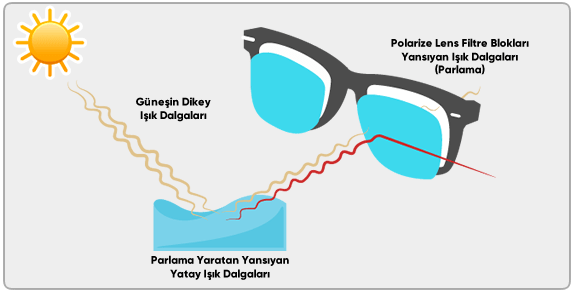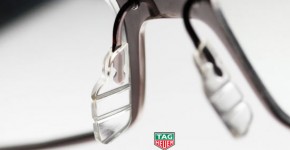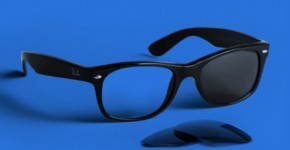Polarize Testi: Güneş Gözlüğünün Polarize Olduğu Nasıl Anlaşılır?

Güneş Gözlüğünün Polarize Olduğu Nasıl Anlaşılır?
İyi bir çift polarize güneş gözlüğünün önemini, tekne ile bir denize açıldığınızda veya balık tutarken daha iyi anlarsınız. Polarize güneş gözlükleri size havalı bir tarz katmaktan daha fazlasını sunar. Çünkü iyi bir çift polarize güneş gözlüğü aynı zamanda UV koruması da sağlar. Polarize filtreler; su, yol veya camdan gelen ışıktan kaynaklanan parlamayı azaltırlar.
Polarize Ne Demektir?
Polarize güneş gözlükleri bir kimyasalla işlenir. Bu, bir kaplama olarak uygulanabileceği gibi cama gömülüde olabilir. Hedeflenen amaç: parlamada önemli bir azalma sağlamasıdır.
Bir şeyleri görmemizi sağlayan olay ışığın o nesnelerden yansımasıdır. Herhangi bir nesneden yansıyan ışık, o nesneyi net bir şekilde görmemizi sağlar. Güneş parlak olduğunda, ışık dokunduğu her yüzeyden yansır. Bu durum açık sular gibi oldukça yansıtıcı yüzeylerde daha fazladır. Işık her yere dağılır ve görmemizi zorlaştırır.
İşte polarize güneş gözlüklerindeki kaplama burada anahtar faktördür. Su veya parlak yüzeyden yansıyan yatay ışık ışınlarını emilirken; dikey ışınlar hala geçebilir, ancak yansıyan ışığın parlaması ortadan kalkar.
Polarize Gözlükler Neden Önemlidir?
Polarize kaplamalı camlar, önünüzde ne olduğunu açıkça görme yeteneğinizi geliştirir. Bundan dolayı polarize lensler kamyoncular, kayıkçılar ve olta balıkçılarının yanı sıra özellikle su sporları yapanlar için idealdir. Parlama yapan yani ışık yansımalarının olduğu bir ortamda veya net görmeniz gerektiğinde ancak yansıtıcı bir yüzeyle karşı karşıya olduğunuzda idealdirler. Açıkcası gölge veya karanlık bir ortamda polarize kaplama bir camın çok bir aynı fonksiyonu yok denilebilir.
Parlamanın neden olduğu ciddi göz yorgunluğu kazalara neden olabilir. Parlamada gizlenen şeyleri kaçırmak kolaydır. Etkili bir şekilde önünüzde bir kör nokta oluşturur. Sakin sularda, güneş yeterince parlaksa beyaz bir nokta yaşarsınız. Bu o kadar büyük olabilir ki, bütün bir tekne gözünüzün önünde kaybolabilir.
Ayrıca, kamaşma sonrası yanma etkisine yol açar. Işıktan uzaklaştığınızda bile, gözlerinizin alışması için zamana ihtiyacı vardır. Parıldayan görüntü, kısa bir süre için görüşünüze yansıyacaktır.
Kaliteli normal güneş gözlükleri gibi, polarize lensler de UV radyasyonunu azaltır. Suda çok fazla zaman harcıyorsanız UV koruması çok önemlidir.
UV Radyasyonunun Tehlikesi
Güneşe her çıktığınızda, gözlerinizi korumak için gözlüğe ihtiyacınız vardır. UV ışınlarının verdiği zarar göz tabiki göz ardı edilemez.
UV radyasyonu katarakt, makula dejenerasyonu ve hatta kornea güneş yanıklarına yol açabilir.
Dikkat edilmesi gereken bir şey, satın aldığınız lenslerin nasıl UV koruması sağladığıdır. Ucuz camlar, yüksek UV koruması sağladıklarını söyleyebilir, ancak bu yalnızca kaplama üzerine püskürtülmesinin sonucudur. Bu, camları temizlediğinizde çıkacaktır. Bu, sizi hiçbir koruma sağlamayan renkli camlarla baş başa bırakacaktır.
Güneş Gözlüğünüzün Polarize Olduğunu Nasıl Anlarsınız?
Polarize gözlükler normal güneş gözlüklerinden çok farklı görünmezler. Bu da, polarize bir gözlüğünüzün olup olmadığını anlamakta zorlanabileceğiniz anlamına gelir. Daha da kötüsü, bazı düşük kaliteli gözlükler, polarize olmadıkları halde kendilerini polarize olarak pazarlarlar. Güneş gözlüklerinizin polarize olup olmadığını belirlemek için kullanabileceğiniz birkaç yöntem vardır.
1. Tek Gözlük Yöntemi
Gözlüklerinizle parlak, yansıtıcı bir ışık kaynağına (örneğin cam, su veya cilalı metal) bakın. Başınızı yaklaşık 60 derece yana eğdiğinizde ışığın yoğunluğu artıyorsa, yani hafif bir kararma oluyorsa polarize güneş gözlüğü takıyorsunuz demektir. Görüntüde bir değişiklik olmazsa, sadece renklendirilmiş camları olan bir gözlüğünüz var demektir.
2. İki Gözlük Yöntemi
Halihazırda bir polarize gözlüğünüz var ve yeni gözlüğünüzün de polarize olup olmadığını kontrol etmek mi istiyorsunuz? Sadece bir çifti diğerinin önünde tutun. Her iki lensten de görebilmeniz gerekir. Şimdi bir çifti dik açıyla döndürün. Lensler siyaha karışırsa, sır ortaya çıkar: İki çift polarize gözlüğünüz var.
3. Dijital Ekran Kullanma Yöntemi
Gözlüklerinizle bir dizüstü bilgisayar, tablet, cep telefonu veya GPS gibi bir LED veya LCD ekrana bakın. Başlangıçta ekran loş olacaktır, ancak başınızı eğdiğinizde siyaha dönerse, bu gözlük camlarınızın polarize sihrini yaptığının kanıtıdır.
4. Test Kartı Yöntemi
Polarizasyon test kartları (polarize tester), güneş gözlüklerini test etmenin başka bir hızlı yoludur. Polarize gözlük satan birçok işletme ve web sitesinde bu kartları bulabilirsiniz. Dilerseniz bu ürünü kontrol edebilirsiniz. Gerçek polarize lenslerle bakıldığında kartta bir görüntü belirecektir. Çıplak gözle veya normal güneş gözlükleriyle bakarsanız, boş görünürler.






